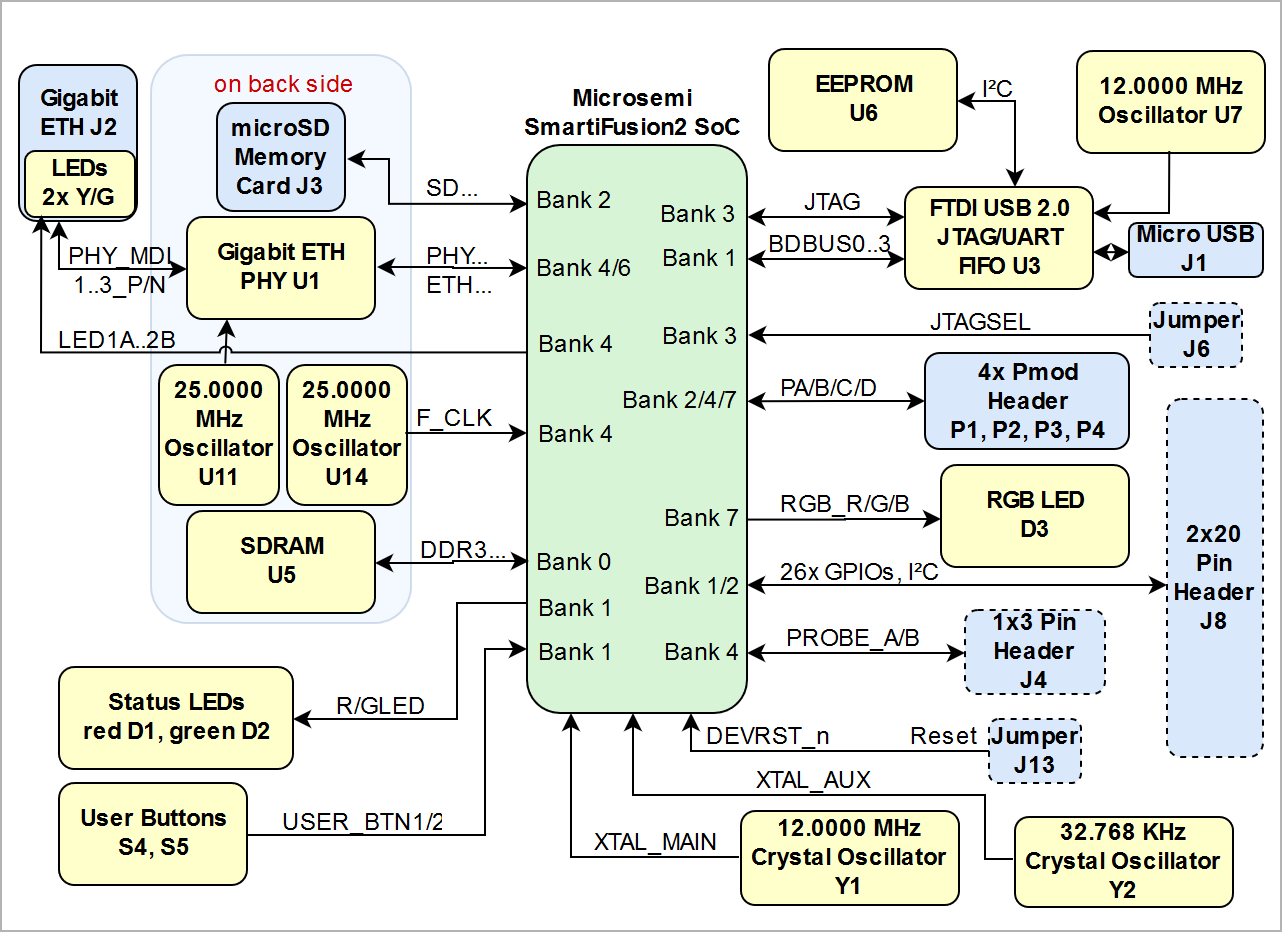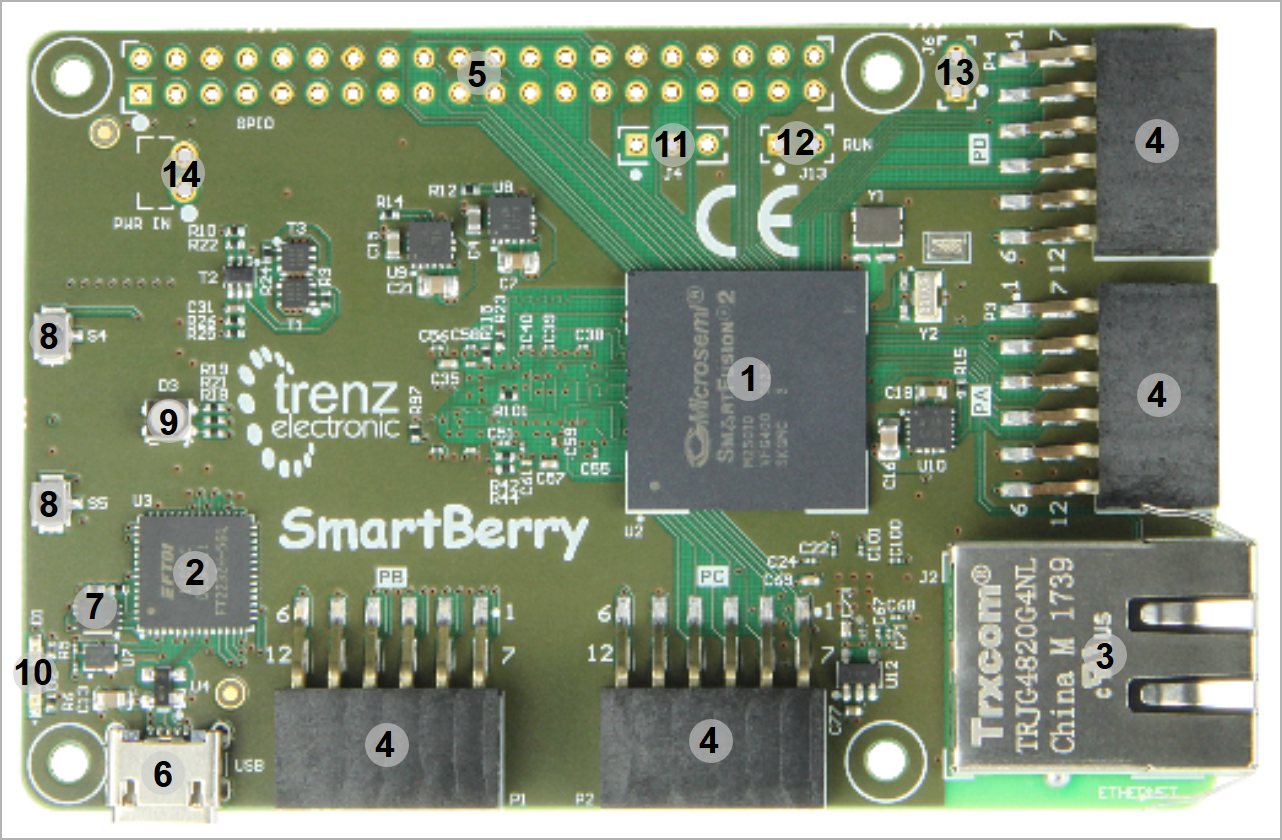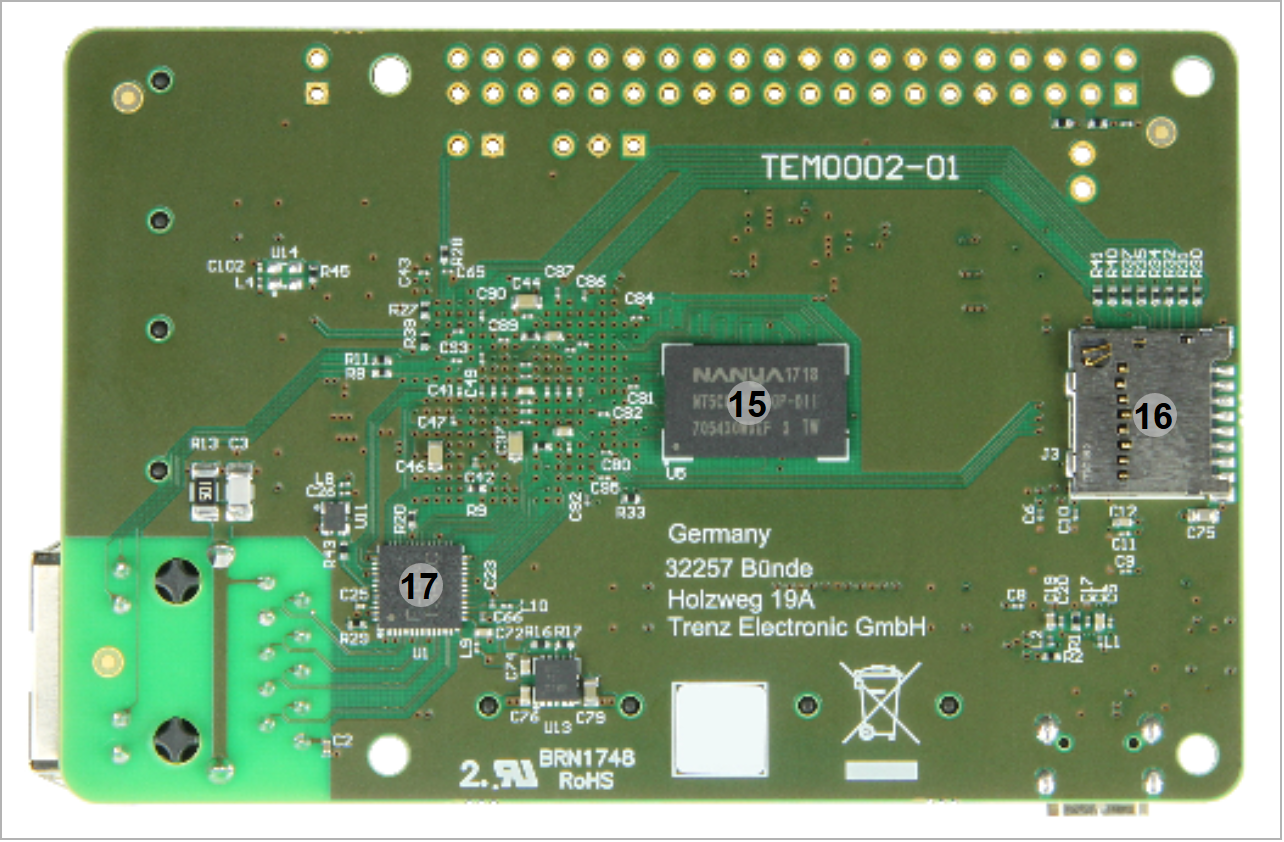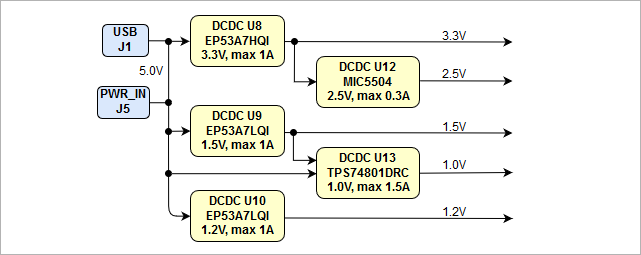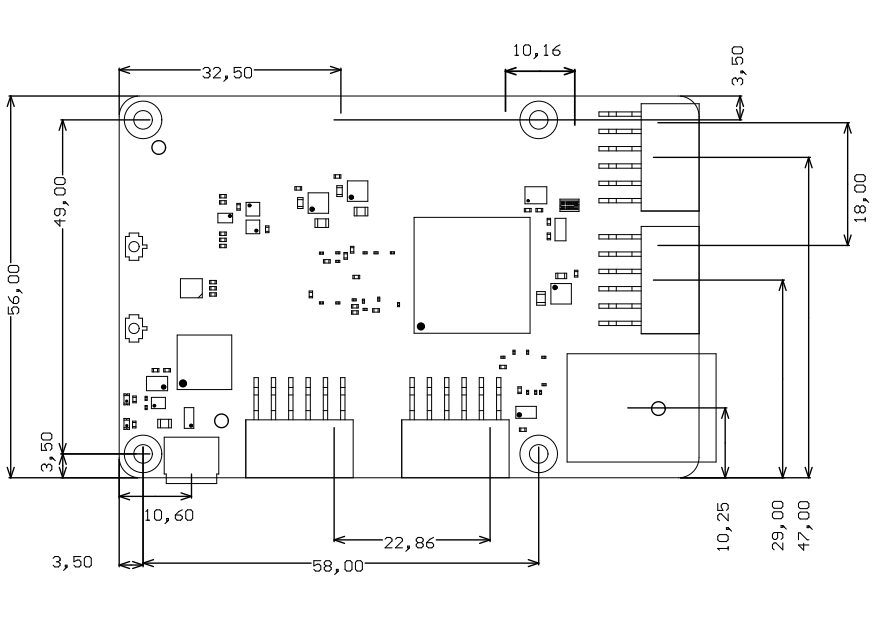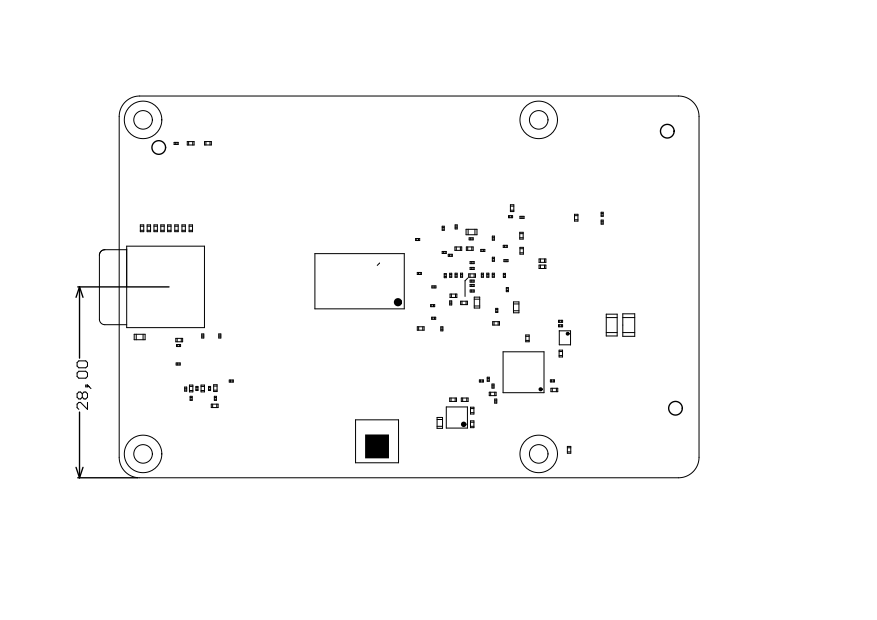Page History
...
| Scroll pdf ignore | |
|---|---|
Table of Contents
|
Overview
| HTML |
|---|
<!-- Wiki Link: Go to Base Folder of the Module or Carrier, for example : https://wiki.trenz-electronic.de/display/PD/TE0712 --> |
| Scroll Only (inline) |
|---|
Refer to httpshttp://wiki.trenz-electronic.de/display/PD/<name>org/tem0002-info for the current online version of this manual and other available documentation. |
The Trenz Electronic TEM0002-01 SmartBerry with Raspberry Pi form factor, is an industrial-grade module based on Microsemi SmartFusion2 SoC (System on a Chip). The Module has 128MB DDR3 SDRAM, a Gigabit Ethernet PHY, Micro USB, four PMODs and four Pmods, a GPIO Pin header compatible to the Raspberry Pi pinout and a Micro USB to UART interface. SmartFusion2 combiens combines a 166 MHz Cortex-M3 core with 256 KByte Flash, 80 KByte SRAM and a 12 kLUT FPGA Core Logiccore logic.
Key Features
- Microsemi SmartFusion2 SoC FPGA (M2S010)
- 128 MByte DDR3 SDRAM
- On board power converters for all needed voltages
- 40 pin header (compatible to Raspberry Pi pinout)
- 4 x 12 pin PMODsPmods
- Gigabit Ethernet PHY with RGMII interface
- JTAG and UART via Micro USB
- 3 pin header for Live Probes
- 2 x User Button
- 2 x status LED
1 x RGB LED
Additional assembly options are available for cost or performance optimization upon request.
Block Diagram
...
| Scroll Title |
|---|
...
|
|
...
|
...
|
...
|
...
|
...
|
...
|
...
|
...
|
...
...
Main Components
| Scroll Title | |||||||||||||||
|---|---|---|---|---|---|---|---|---|---|---|---|---|---|---|---|
| |||||||||||||||
|
...
|
...
|
...
|
...
|
...
Table 1: TEM0002-01 main components.
|
- Microsemi SmartFusion2 SoC FPGA, U2
- USB to
- Microsemi SmartFusion2 SoC FPGA, U2
- USB to UART/FIFO (FTDI FT2232H), U3
- Gigabit ETH connector, J2
- 4x 2x6 pin PMODPmod, P1, P2, P3, P4
- GPIO pin header compatible to Raspberry Pi, J8
- Micro USB 2.0, J1
- EEPROM 4KBIT (M93C66-R), U6
- 2x User Button, S4, S5
- RGB LED, D3
- LED red, D1 and green, D2
- Live Probe pins, J4
- Reset jumper, J13
- JTAG select jumper, J6
- Board power header, J5
- 1Gb DDR3/L SDRAM, U5
- MicroSD memory card connector, J3
- Gigabit Ethernet PHY, U1
Initial Delivery State
Storage device name | Content | Notes | |||
|---|---|---|---|---|---|
.. | .. | .. | |||
| Microsemi SmartFusion2 SoC FPGA, U2 | Demo Design | - | |||
| EEPROM, U6 | Programmed | FTDI (FT2232H) configuration data | OTP Flash area | Empty | Not programmed. |
Table 1: Initial delivery state of programmable devices on the module.
Boot Process
By default the ... supports QSPI and SD Card boot modes which is controlled by the MODE input signal from the B2B connector JM..
...
MODE Signal State
...
High or open
...
SD Card
...
Low or ground
...
QSPI Interface
The SmartBerry supports configuration of the system via JTAG by the FTDI USB bridge.
Signals, Interfaces and Pins
Table 2: Selecting power-on boot device.
Signals, Interfaces and Pins
| HTML |
|---|
<!-- Connections and Interfaces or B2B Pin's which are accessible by User --> |
...
I/Os
26 I/O signals connected to the SoCs I/O bank and B2B connector:
...
Table x: General overview of PL I/O signals connected to the B2B connectors.
All PS MIO banks are powered by on-module DC-DC power rail. All PL I/O banks have separate VCCO input pins in the B2B connectors, valid VCCO should be supplied from the carrier board.
For detailed information about the pin out, please refer to the Pin-out Tables.
The configuration of the PS I/Os MIOx, MIOx ... MIOx, ... depend on the carrier board peripherals connected to these pins.
| HTML |
|---|
<!--
TO-DO (future):
If Vivado board part files are available for this module, the standard configuration of the MIO pins by using this board part files should be mentioned here. This standard configuration of those pins are also apparent of the on-board peripherals of base-boards related to the module.
--> |
MGT Lanes
| HTML |
|---|
<!--
MGT lanes should be listed separately, as they are more specific than just general I/Os.
--> |
MGT (Multi Gigabit Transceiver) lane consists of one transmit and one receive (TX/RX) differential pairs, two signals each or four signals total per one MGT lane. Following table lists lane number, MGT bank number, transceiver type, signal schematic name, board-to-board pin connection and FPGA pins connection:
...
- MGT_RX0_P
- MGT_RX0_N
- MGT_TX0_P
- MGT_TX0_N
...
- JM3-8
- JM3-10
- JM3-7
- JM3-9
...
- MGTHRXP0_225, Y2
- MGTHRXN0_225, Y1
- MGTHTXP0_225, AA4
- MGTHTXN0_225, AA3
...
- MGT_RX1_P
- MGT_RX1_N
- MGT_TX1_P
- MGT_TX1_N
...
- JM3-14
- JM3-16
- JM3-13
- JM3-15
...
- MGTHRXP1_225, V2
- MGTHRXN1_225, V1
- MGTHTXP1_225, W4
- MGTHTXN1_225, W3
...
- MGT_RX4_P
- MGT_RX4_N
- MGT_TX4_P
- MGT_TX4_N
...
- JM1-12
- JM1-10
- JM1-6
- JM1-4
...
- MGTHRXP0_224, AH2
- MGTHRXN0_224, AH1
- MGTHTXP0_224, AG4
- MGTHTXN0_224, AG3
...
- MGT_RX5_P
- MGT_RX5_N
- MGT_TX5_P
- MGT_TX5_N
...
- JM1-24
- JM1-22
- JM1-18
- JM1-16
...
- MGTHRXP1_224, AF2
- MGTHRXN1_224, AF1
- MGTHTXP1_224, AF6
- MGTHTXN1_224, AF5
...
provided on the Rasperry Pi compatible header are connected to banks with 3.3V. Dpending on the configuration of the SoC, also GPIOs of the Microprocessor subsystem can be routet to the SoC Pins.
| FPGA SoC Signal | SOC Pin | Header Pin | Raspberry Pi Signal |
|---|---|---|---|
| MSIO19PB2 | U2-H16 | 3 | GPIO2 |
| MSIO16PB2 | U2-J17 | 5 | GPIO3 |
| MSIO2PB2 | U2-T18 | 7 | GPIO4 |
| MSIO1PB2 | U2-U18 | 8 | GPIO14 |
| MSIO5NB2 | U2-R18 | 10 | GPIO15 |
| MSIO11NB2 | U2-M17 | 11 | GPIO17 |
| MSIO6PB2 | U2-P18 | 12 | GPIO18 |
| MSIO14PB2 | U2-L15 | 13 | GPIO27 |
| MSIO17PB2 | U2-K16 | 15 | GPIO22 |
| MSIO11PB2 | U2-N16 | 16 | GPIO23 |
| MSIO27NB1 | U2-B19 | 18 | GPIO24 |
| MSIO25NB1 | U2-C20 | 19 | GPIO10 |
| MSIO25PB1 | U2-D20 | 21 | GPIO9 |
| MSIO22NB1 | U2-F18 | 22 | GPIO25 |
| MSIO20NB2 | U2-F20 | 23 | GPIO11 |
| MSIO20PB2 | U2-G19 | 24 | GPIO08 |
| MSIO18PB2 | U2-H19 | 26 | GPIO07 |
| MSIO28PB1 | U2-A20 | 27 | ID_SDA |
| MSIO28NB1 | U2-A19 | 28 | ID_SCL |
| MSIO16NB2 | U2-J18 | 29 | GPIO05 |
| MSIO15NB2 | U2-J20 | 31 | GPIO06 |
| MSIO15PB2 | U2-K20 | 32 | GPIO12 |
| MSIO14NB2 | U2-L16 | 33 | GPIO13 |
| MSIO13NB2 | U2-L19 | 35 | GPIO19 |
| MSIO13PB2 | U2-L20 | 36 | GPIO16 |
| MSIO8PB2 | U2-N20 | 37 | GPIO26 |
| MSIO8NB2 | U2-M19 | 38 | GPIO20 |
| MSIO4NB2 | U2-N19 | 40 | GPIO21 |
Table 2: General overview of I/O signals connected to the SoC.
Further I/Os are provided via the Pmod connectors descriebed below.
Pmods
The module provides four 2x6 female Pmod connectors. Two of the headers (P2 and P3) are arranged to use as dual 12 pin Pmod. According to the standard on all four headers Pin 5 and 11 are connected to ground, 6 and 12 to 3.3V.
| FPGA SoC Signal | Pin | Pmod Signal | Pmod Pin |
|---|---|---|---|
| MSIO71PB7 | U2-F3 | PB-01 | P1-1 |
| MSIO71NB7 | U2-F4 | PB-02 | P1-2 |
| MSIO68NB7 | U2-E3 | PB-03 | P1-3 |
| MSIO80NB7 | U2-H4 | PB-04 | P1-4 |
| MSIO75PB7 | U2-G4 | PB-05 | P1-7 |
| MSIO75NB7 | U2-F5 | PB-06 | P1-8 |
| MSIO67NB7 | U2-E5 | PB-07 | P1-9 |
| MSIO78NB7 | U2-G3 | PB-08 | P1-10 |
| MSIO79PB7 | U2-G1 | PC-01 | P2-1 |
| MSIO79NB7 | U2-F1 | PC-02 | P2-2 |
| MSIO70NB7 | U2-E2 | PC-03 | P2-3 |
| MSIO64PB7 | U2-C1 | PC-04 | P2-4 |
| MSIO78PB7 | U2-G2 | PC-05 | P2-7 |
| MSIO70PB7 | U2-E1 | PC-06 | P2-8 |
| MSIO68PB7 | U2-D2 | PC-07 | P2-9 |
| MSIO64NB7 | U2-C2 | PC-08 | P2-10 |
| MSIO117NB4 | U2-Y16 | PA-01 | P3-1 |
| MSIO117PB4 | U2-Y15 | PA-02 | P3-2 |
| MSIO112PB4 | U2-W13 | PA-03 | P3-3 |
| MSIO110PB4 | U2-V12 | PA-04 | P3-4 |
| MSIO118PB4 | U2-W15 | PA-05 | P3-7 |
| MSIO112NB4 | U2-W14 | PA-06 | P3-8 |
| MSIO105NB4 | U2-Y13 | PA-07 | P3-9 |
| MSIO104PB4 | U2-V11 | PA-08 | P3-10 |
| MSIO4PB2 | U2-P20 | PD-01 | P4-1 |
| MSIO3NB2 | U2-R20 | PD-02 | P4-2 |
| MSIO2NB2 | U2-T19 | PD-03 | P4-3 |
| MSIO0PB2 | U2-V20 | PD-04 | P4-4 |
| MSIO6NB2 | U2-P19 | PD-05 | P4-7 |
| MSIO3PB2 | U2-T20 | PD-06 | P4-8 |
| MSIO1NB2 | U2-U19 | PD-07 | P4-9 |
| MSIO0NB2 | U2-V19 | PD-08 | P4-10 |
Table 3: Overview of Pmod signals connected to the SoC.
JTAG Interface
JTAG access to the SoC components is provided through the micro usb connector via the FTDI usb to UART bridge. Depending on the jumper J6 the JTAGSEL signal SW3 switches the JTAG interface to either the FPGA fabric TAP (OPEN, high) or the Cortex-M3 JTAG debug interface (CLOSED, low). JTAG signals are powered by 3.3V.
FTDI signal | pin | JTAG Signal | Microsemi SmartFusion2 SoC pin |
|---|---|---|---|
| ADBUS0 | U3-12 | TCK | U2-W19 |
| ADBUS1 | U3-13 | TDI | U2-V16 |
| ADBUS2 | U3-14 | TDO | U2-Y20 |
| ADBUS3 | U3-15 | TMS | U2-V17 |
Table 4: JTAG interface signals.
SD Card Interface
The SD Card interface is connected to bank 2 of the SoC
| FPGA / SoC Pin | Connected To | Signal Name | Notes |
|---|---|---|---|
| U2-H16 | J3-9 | SD_CD | Card detect switch |
| U2-N15 | J3-7 | SD_D0 | |
| U2-G18 | J3-8 | SD_D1 | |
| U2-R16 | J3-1 | SD_D2 | |
| U2-R17 | J3-2 | SD_D3 | |
| U2-R15 | J3-3 | SD_CMD | |
| U2-P15 | J3-5 | SD_CLK |
Table 5: SD Card interface signals and connections.
Ethernet Interface
| PHY Pin | Signal | Microsemi SmartFusion2 SoC signal | Pin | Notes |
|---|---|---|---|---|
| U1-25 | ETH_TXCK | MSIOD84PB6 | U2-K7 | |
| U1-23 | ETH_TXCTL | MSIOD87NB6 | U2-K3 | |
| U1-26 | ETH_TXD0 | MSIOD93PB6 | U2-L1 | |
| U1-28 | ETH_TXD1 | MSIOD97NB6 | U2-M2 | |
| U1-29 | ETH_TXD2 | MSIOD97PB6 | U2-M1 | |
| U1-30 | ETH_TXD3 | MSIOD95PB6 | U2-M3 | |
| U1-22 | ETH_RRXCK | MSIOD84PB6 | U2-J2 | |
| U1-21 | ETH_RRXCTL | MSIOD93NB6 | U2-K1 | |
| U1-20 | ETH_RRXD0 | MSIOD86PB6 | U2-K5 | |
U1-18 | ETH_RRXD1 | MSIOD82PB6 | U2-H1 | |
| U1-17 | ETH_RRXD2 | MSIOD82NB6 | U2-H2 | |
| U1-16 | ETH_RRXD3 | MSIOD83PB6 | U2-J4 | |
| U1-31 | ETH_MDC | MSIOD99PB6 | U2-N1 | |
| U1-33 | ETH_MDIO | MSIOD99NB6 | U2-N2 | |
| U1-34 | ETH_MDINT | MSIOD98PB6 | U2-N4 | |
| U1-35 | ETH_RST | MSIO114PB4 | U2-R13 | |
| U1-36 | PHY_RCLKOUT | MSIO102NB4/CCC_NE1_CLKIO | U2-W10 | |
| U1-39 | PHY_LED0 | MSIO104NB4 | U2-U11 | |
| U1-38 | PHY_LED1 | MSIO116PB4 | U2_T14 |
Table 6: Ethernet PHY signals and connections.
I2C Interface
There are no on-board I2C devices. For Raspberry Pi compability the device detection I2C bus is routed from the header J8-27/28 to Bank 1 U2-A20/A19 (SDA/SCL).
| I2C Device | I2C Address | Notes |
|---|---|---|
| Header J8 | 0x50 | Device detection/identification. |
Table 7: I2C slave device addresses.
On-board Peripherals
| HTML |
|---|
<!--
Components on the Module, like Flash, PLL, PHY...
--> |
DDR Memory
TEM0002 has 1Gb industrial grade DDR3 SDRAM (U5). A 16-bit wide memory bus providing total of 128 MBytes of on-board RAM. Specification is 800 MHz clocking resulting in 1600 Mb/s data rate and timings of 11-11-11 (CL-TRCD-TRP).
Gigabit Ethernet PHY
On-board Gigabit Ethernet PHY (J2) is provided by Microsemi VSC8531 chip (U1). The Ethernet PHY RGMII interface is connected to bank 6 of the Microsemi SOC. I/O voltage is fixed at 1.5V. The reference clock input of the PHY is supplied from an external 25.000000 MHz oscillator (U11).
Oscillators
The module has following reference clock signals provided by on-board oscillators:
| Clock Source | Schematic Name | Frequency | Clock Destination |
|---|---|---|---|
| Crystal CX3225CA25000D0HSSCC | Y1 | 25.000 MHz1 | SmartFusion2 SoC U2 Main XTAL |
| Crystal ECX-31B | Y2 | 32.768 KHz | SmartFusion2 SoC U2 AUX XTAL |
| SiTime SiT8008AI oscillator | U11 | 25.000000 MHz | Gb Ethernet Copper PHY U1A |
| SiTime SiT8008AI oscillator | U14 | 25.000000 MHz | SmartFusion2 SoC U2-Y12 Bank 4 |
Table 8: Reference clock signals.
1In REV02, Y1 will be replaced by a 12 MHz crystal.
On-board LEDs
| LED | Color | Connected to | SoC FPGA Signal | Description and Notes |
|---|---|---|---|---|
| D1 | Red | U2-G16 Bank 1 | MSIO21PB1 | |
| D2 | Green | U2-G17 Bank 1 | MSIO21NB1 | |
| D3 | RGB | U2-H5 Bank 7, U2-F6 Bank 7, U2-H6 Bank 7 | MSIO80PB7, MSIO67PB7, MSIO81NB7 | |
| J2 | Green, Yellow | U2-Y10 Bank 4, U2-U12 Bank 4 | MSIO102PB4, MSIO110NB4 | Ethernet: LED1A, LED1B |
| J2 | Green, Yellow | U2-V14 Bank 4, U2-U14 Bank 4 | MSIO115PB4, MSIO115PB4 | Ethernet: LED2A, LED2B |
Table 9: On-board LEDs.
On-board Buttons
| Button | Connected to | SoC FPGA Signal |
|---|---|---|
| S4 | U2-E17 Bank 1 | MSIO24PB1 |
| S5 | U2-E16 Bank 1 | MSIO24NB1 |
Table 10: On-board Buttons.
Power and Power-On Sequence
There is no specific power on Sequence. Just supply with 5V via the micro USB J1 or the J5 PWR_IN with current rating sufficient for your Design.
| HTML |
|---|
<!--
If power sequencing and distribution is not so much, you can join both sub sections together
--> |
Power Consumption
The maximum power consumption of a module mainly depends on the design running on the FPGA.
| Power Input | Typical Current |
|---|---|
| VIN | TBD* |
| 3.3VIN | TBD* |
Table 11: Typical power consumption.
* TBD - To Be Determined soon with reference design setup.
Power supply with minimum current capability of ...A for system startup is recommended.
For the lowest power consumption and highest efficiency of the on-board DC-DC regulators it is recommended to power the module from one single 3.3V supply. All input power supplies have a nominal value of 3.3V. Although the input power supplies can be powered up in any order, it is recommended to power them up simultaneously.
Power Distribution Dependencies
| Scroll Title | ||||||||||||||||||||||||||||||
|---|---|---|---|---|---|---|---|---|---|---|---|---|---|---|---|---|---|---|---|---|---|---|---|---|---|---|---|---|---|---|
| ||||||||||||||||||||||||||||||
|
Power Rails
Power Rail Name | Connector pin | Direction | Notes |
|---|---|---|---|
| VIN | J5-1 | Input | Main supply voltage. |
| 5V | J8-2, J8-4 | Output | |
| 3.3V | J8-1, J8-17 | Output | |
| 1.5V | - | Output | |
1.2V | - | Output | |
| GND | J5-2, J8-9/25/39/6/14/20/30/34 |
Table 12: Module power rails.
Bank Voltages
Bank | Schematic Name | Voltage | Voltage Range |
|---|---|---|---|
| 0 (DDR3) | 1.5V | 1.5V | - |
| 1 | 3.3V | 3.3V | - |
| 2 | 3.3V | 3.3V | - |
| 3 | 3.3V | 3.3V | - |
| 4 | 3.3V | 3.3V | - |
| 5 | 1.5V | 1.5V | - |
| 6 | 1.5V | 1.5V | - |
| 7 | 3.3V | 3.3V | - |
Table 13: I/O bank voltages.
Variants Currently In Production
| Module Variant | FPGA / SoC | Operating Temperature | Temperature Range |
|---|---|---|---|
| TEM0002-01 | M2S010 | 0°C to +70°C | commercial |
Table 14
Table x: MGT lanes.
Below are listed MGT banks reference clock sources.
...
Table x: MGT reference clock sources.
JTAG Interface
JTAG access to the ... is provided through B2B connector ....
...
JTAG Signal
...
B2B Connector Pin
...
Table 5: JTAG interface signals.
System Controller CPLD I/O Pins
Special purpose pins are connected to smaller System Controller CPLD and have following default configuration:
...
Table x: System Controller CPLD I/O pins.
| HTML |
|---|
<!--
For the detailed function of the pins and signals, the internal signal assignment and implemented logic, look to the Wiki reference page SC CPLD of this module or into the bitstream file of the SC CPLD.
Add link to the Wiki reference page of the SC CPLD, if available.
--> |
Quad SPI Interface
Following line is just an example, change it to your needs.
Quad SPI Flash (U14) is connected to the Zynq PS QSPI0 interface via PS MIO bank 500, pins MIO1 ... MIO6.
Note that table column says "Signal Name", it should match the name used on the schematic.
...
Table x: Quad SPI interface signals and connections.
SD Card Interface
Describe SD Card interface shortly here if the module has one...
...
Table x: SD Card interface signals and connections.
Ethernet Interface
On board Gigabit Ethernet PHY is provided with ...
Ethernet PHY connection
...
Table x: ...
USB Interface
USB PHY is provided with ...
...
Table x: ...
The schematic for the USB connector and required components is different depending on the USB usage. USB standard A or B connectors can be used for Host or Device modes. A Mini USB connector can be used for USB Device mode. A USB Micro connector can be used for Device mode, OTG Mode or Host Mode.
I2C Interface
On-board I2C devices are connected to MIO.. and MIO.. which are configured as I2C... by default. I2C addresses for on-board devices are listed in the table below:
...
Table x: I2C slave device addresses.
On-board Peripherals
| HTML |
|---|
<!--
Components on the Module, like Flash, PLL, PHY...
--> |
System Controller CPLD
The System Controller CPLD (U2) is provided by Lattice Semiconductor LCMXO2-256HC (MachXO2 Product Family). The SC-CPLD is the central system management unit where essential control signals are logically linked by the implemented logic in CPLD firmware, which generates output signals to control the system, the on-board peripherals and the interfaces. Interfaces like JTAG and I2C between the on-board peripherals and to the FPGA module are by-passed, forwarded and controlled by the System Controller CPLD.
Other tasks of the System Controller CPLD are the monitoring of the power-on sequence and to display the programming state of the FPGA module.
For detailed information, refer to the reference page of the SC CPLD firmware of this module.
| HTML |
|---|
<!--
Put in link to the Wiki reference page of the firmware of the SC CPLD.
--> |
DDR Memory
By default TE0xxx module has ... DDRx SDRAM chips arranged into 32-bit wide memory bus providing total of 1 GBytes of on-board RAM. Different memory sizes are available optionally.
Quad SPI Flash Memory
On-board QSPI flash memory (U14) on the TE0745-02 is provided by Micron Serial NOR Flash Memory N25Q256A with 256 Mbit (32 MByte) storage capacity. This non volatile memory is used to store initial FPGA configuration. Besides FPGA configuration, remaining free flash memory can be used for user application and data storage. All four SPI data lines are connected to the FPGA allowing x1, x2 or x4 data bus widths. Maximum data rate depends on the selected bus width and clock frequency used.
| Note |
|---|
SPI Flash QE (Quad Enable) bit must be set to high or FPGA is unable to load its configuration from flash during power-on. By default this bit is set to high at the manufacturing plant. |
Gigabit Ethernet PHY
On-board Gigabit Ethernet PHY (U7) is provided with Marvell Alaska 88E1512 IC (U8). The Ethernet PHY RGMII interface is connected to the Zynq Ethernet0 PS GEM0. I/O voltage is fixed at 1.8V for HSTL signaling. The reference clock input of the PHY is supplied from an on-board 25.000000 MHz oscillator (U9), the 125MHz output clock signal CLK_125MHZ is connected to the pin J2-150 of B2B connector J2.
High-speed USB ULPI PHY
Hi-speed USB ULPI PHY (U32) is provided with USB3320 from Microchip. The ULPI interface is connected to the Zynq PS USB0 via MIO28..39, bank 501 (see also section). The I/O voltage is fixed at 1.8V and PHY reference clock input is supplied from the on-board 52.000000 MHz oscillator (U33).
MAC Address EEPROM
A Microchip 24AA025E48 serial EEPROM (U23) contains a globally unique 48-bit node address, which is compatible with EUI-48(TM) specification. The device is organized as two blocks of 128 x 8-bit memory. One of the blocks stores the 48-bit node address and is write protected, the other block is available for application use. It is accessible over I2C bus with slave device address 0x53.
Oscillators
The module has following reference clock signals provided by on-board oscillators and external source from carrier board:
...
25.000 MHz
...
Table : Reference clock signals.
On-board LEDs
...
U2-H5 Bank 7, U2-F6 Bank 7, U2-H6 Bank 7
...
Table : On-board LEDs.
Power and Power-On Sequence
| HTML |
|---|
<!--
If power sequencing and distribution is not so much, you can join both sub sections together
--> |
Power Consumption
The maximum power consumption of a module mainly depends on the design running on the FPGA.
Xilinx provide a power estimator excel sheets to calculate power consumption. It's also possible to evaluate the power consumption of the developed design with Vivado. See also Trenz Electronic Wiki FAQ.
...
Table : Typical power consumption.
* TBD - To Be Determined soon with reference design setup.
Power supply with minimum current capability of ...A for system startup is recommended.
For the lowest power consumption and highest efficiency of the on-board DC-DC regulators it is recommended to power the module from one single 3.3V supply. All input power supplies have a nominal value of 3.3V. Although the input power supplies can be powered up in any order, it is recommended to power them up simultaneously.
The on-board voltages of the TE07xx SoC module will be powered-up in order of a determined sequence after the external voltages '...', '...' and '...' are available. All those power-rails can be powered up, with 3.3V power sources, also shared. <-- What?
| Warning |
|---|
| To avoid any damage to the module, check for stabilized on-board voltages should be carried out(i.e. power good and enable signals) before powering up any SoC's I/O bank voltages VCCO_x. All I/Os should be tri-stated during power-on sequence. |
Power Distribution Dependencies
Regulator dependencies and max. current.
Put power distribution diagram here...
Figure : Module power distribution diagram.
See Xilinx data sheet ... for additional information. User should also check related base board documentation when intending base board design for TE07xx module.
Power-On Sequence
The TE07xx SoM meets the recommended criteria to power up the Xilinx Zynq MPSoC properly by keeping a specific sequence of enabling the on-board DC-DC converters dedicated to the particular functional units of the Zynq chip and powering up the on-board voltages.
Following diagram clarifies the sequence of enabling the particular on-board voltages, which will power-up in descending order as listed in the blocks of the diagram:
Put power-on diagram here...
Figure : Module power-on diagram.
Voltage Monitor Circuit
If the module has one, describe it here...
Power Rails
NB! Following table with examples is valid for most of the 4 x 5 cm modules but depending on the module model and specific design, number and names of power rails connected to the B2B connectors may vary.
...
Power Rail Name
...
B2B JM1 Pins
...
B2B JM2 Pins
...
Direction
...
VBAT_IN
...
Table : Module power rails.
Different modules (not just 4 x 5 cm ones) have different type of connectors with different specifications. Following note is for Samtec Razor Beam™ LSHM connectors only, but we should consider adding such note into included file in Board to Board Connectors section instead of here.
| Note |
|---|
Current rating of Samtec Razor Beam™ LSHM B2B connectors is 2.0A per pin (2 adjacent pins powered). |
Bank Voltages
...
Bank
...
Voltage
...
Voltage Range
...
Table : Module PL I/O bank voltages.
Board to Board Connectors
| HTML |
|---|
<!--
Generate new entry:
Replace with correct on for selected module series
--> |
...
Variants Currently In Production
NB! Note that here we look at the module as a whole, so you just can't rely only on junction temperature or max voltage of particular SoC or FPGA chip on the module. See examples in the table below.
...
Operating Temperature
...
Table : Module variants.
Technical Specifications
Absolute Maximum Ratings
Parameter | Min | Max | Units | Reference Document | |
|---|---|---|---|---|---|
VIN supply voltage | -0.3 | 6.0 | VIN supply voltageV | - | |
Storage temperature1 | -25 | 70 | °C | - |
Table 15: Module absolute maximum ratings.
...
1Boundary determined by the specification of the buttons, all other components have at least a range of -40°C to 85°C.
Recommended Operating Conditions
| Parameter | Min | Max | Units | Reference Document | ||
|---|---|---|---|---|---|---|
| VIN supply voltage | Operating temperature | 2.4 | 5.5 | V | - | |
| Operating temperature1 | 0 | 70 | °C | - |
Table 16Table : Module recommended operating conditions.
| Note |
|---|
| Please check Xilinx datasheet ... for complete list of absolute maximum and recommended operating ratings. |
Operating Temperature Ranges
Commercial grade: 0°C to +70°C.
Extended grade: 0°C to +85°C.
...
1Upper bound is determined by the buttons, all other components have at least a upper bound of 85 °C.
Operating Temperature Ranges
Module operating temperature range depends also on customer design and cooling solution. Please contact us for options.
Physical Dimensions
Module size: 85 mm × 56 mm. Please download the assembly diagram for exact numbers.
PCB thickness: 1.55 mm.
Highest part on PCB: top approx. 13.3 mm (Ethernet), bottom 1.57mm (SD-Card)Please download the step model for exact numbers.
All dimensions are given in millimeters.
| Scroll Title | ||||
|---|---|---|---|---|
| ||||
Revision History
Hardware Revision History
| Date | Revision | Notes | PCN | Documentation Link |
|---|---|---|---|---|
| - | 01 | Prototypes |
Table 17: Module hardware revision history.
...
Hardware revision number can be found on the PCB board together with the module model number separated by the dash.
Put picture of actual PCB showing model and hardware revision number here...
with the module model number separated by the dash.
draw.io Diagram border false viewerToolbar true fitWindow false diagramName Pic_REV_number simpleViewer true width 200 links auto tbstyle top lbox true diagramWidth 1571 revision 3
Figure 5Figure : Module hardware revision number.
Document Change History
| HTML |
|---|
<!-- Generate new entry: 1.add new row below first 2.Copy "Page Information Macro(date)" Macro-Preview, Metadata Version number, Author Name and description to the empty row. Important Revision number must be the same as the Wiki document revision number 3.Update Metadata = "Page Information Macro (current-version)" Preview+1 and add Author and change description. --> |
...
Date | Revision | Contributors | Description | |||||||||||||||||
|---|---|---|---|---|---|---|---|---|---|---|---|---|---|---|---|---|---|---|---|---|
| John Hartfiel | Remove Link to Download | 2017-05-30 | v.1 | Jan Kumann |
|
| |||||||||||||
all | Jan Kumann, John Hartfiel |
Table 18: Document change history.
Disclaimer
| Include Page | ||||
|---|---|---|---|---|
|
